By Margy Nelson
All About Goldenrod
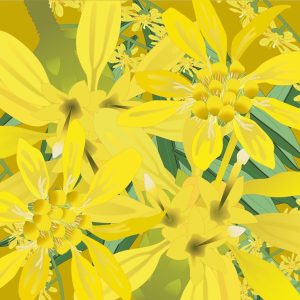 Four years ago I took a few photos of the goldenrod plants growing along our driveway, and noticed that they were positively crawling and buzzing with insects. And thus began a four-year obsession with the small creatures living thereon. It turns out that goldenrod is one of those plants that has co-evolved with a huge number of small animals (invertebrates, mostly) whose lives depend on its presence. As I began reading about the many species whom I had captured on goldenrod with my camera, I began to dream about creating a “catalogue” describing what I had found. I decided that I would only illustrate animals that I had actually observed myself; a complete list of everything that depends on goldenrod for its existence would be encyclopedic!
Four years ago I took a few photos of the goldenrod plants growing along our driveway, and noticed that they were positively crawling and buzzing with insects. And thus began a four-year obsession with the small creatures living thereon. It turns out that goldenrod is one of those plants that has co-evolved with a huge number of small animals (invertebrates, mostly) whose lives depend on its presence. As I began reading about the many species whom I had captured on goldenrod with my camera, I began to dream about creating a “catalogue” describing what I had found. I decided that I would only illustrate animals that I had actually observed myself; a complete list of everything that depends on goldenrod for its existence would be encyclopedic!
Goldenrods are a member of the huge aster family (Asteraceae—including lettuce, daisies, sunflowers, chrysanthemums, asters, dandelions, goldenrod, coneflowers, thistles, artichokes, dahlias, marigolds, zinnias, asters, chamomile, chicory, sage, tarragon, ragweed, sagebrush, and yarrow. As you can see from this list, insects are not the only ones who rely on this family for food).
I discovered when I began trying to draw them that the flowers of the goldenrod are exceedingly complex (it is why the older name for this family of flowers is Compositiae, as each blossom is made up of many diverse parts). Rather than going into that here, let me just suggest that if you’re interested, you search on google for “structure of goldenrod flower” and go on from there. As I have worked on drawings and photos for the show, I was also researching what I found, and the natural scientist in me found lots of amazing stories; I could not resist sharing them. You will find those stories below each piece in my part of the show and also in this pamphlet.
Caterpiggles I and II
 These are the caterpillars of two closely related noctuids, big brown moths, Cucullia asteroides and
Cucullia convexipennis.
These are the caterpillars of two closely related noctuids, big brown moths, Cucullia asteroides and
Cucullia convexipennis.
The larvae of both moths feed on the leaves and flowers of goldenrod and aster; I found both on goldenrod, on September strolls.
C. asteroides, as a caterpillar, loves to fool unwary bug collectors, as its markings vary widely, from deep maroon to the bright green of the one I “captured”. It grows up to become a brown hooded owlet moth.
C. convexipennis on the other hand, though beautifully colored, is more conservative and usually sports the same tasteful design every time you see one. It is also known as the Calico Paint Caterpillar, for obvious reasons. This one grows up to be a goldenrod hooded owlet moth, at which stage, like its cousin, it gives up its gaudy design for a rather sober brown costume.
Both species will become a heavily “furred” brown moth, with highly sculpted groups of the scales that cover all moths; both are good at blending into their backgrounds and pretending to be a twig or a bit of bark. According to the wonderful site Bugguide, “[The] generic epithet Cucullia is [from the] Latin meaning ‘hood’. This refers to the projection of the thorax over the head.” They are talking here about a striking cluster of hairs that project forward from the moth’s thorax over its head, in both species. Since I never saw any of the adults, I did not draw them, but lots of pictures can be found on the web.
My Darling Daddy Long-legs: Leiobunum aldrichi
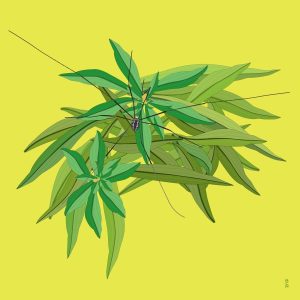 Please Note: This is not a spider! And it is not poisonous! Indeed, to someone our size it is about as dangerous as a dust-bunny (though their closest relatives are probably scorpions).
They are a very ancient group, (the Opilionids—“o-PILL-ee-own-ids”); fossils almost identical to modern opilionids date back more than 400 million years! What that suggests, in Darwinian terms, is that this is a very successful design for survival. Most Opilionids, alas, are a bit boring, according to our local expert; but really that is a testament to their excellent design; they have survived that way for so long, without needing to evolve flamboyant appurtenances or bizarre behaviors in order to flourish. They found their metier long ago and sensibly stuck with it.
Please Note: This is not a spider! And it is not poisonous! Indeed, to someone our size it is about as dangerous as a dust-bunny (though their closest relatives are probably scorpions).
They are a very ancient group, (the Opilionids—“o-PILL-ee-own-ids”); fossils almost identical to modern opilionids date back more than 400 million years! What that suggests, in Darwinian terms, is that this is a very successful design for survival. Most Opilionids, alas, are a bit boring, according to our local expert; but really that is a testament to their excellent design; they have survived that way for so long, without needing to evolve flamboyant appurtenances or bizarre behaviors in order to flourish. They found their metier long ago and sensibly stuck with it.
Mostly these graceful little creatures are omnivores; they scavenge on various sorts of decaying matter, but they also capture small prey if the opportunity arises. So they are quite useful in our gardens, munching on aphids, mites, and other small destructive creatures. One observer of Opilionids has likened them to hyenas, which may seem like a stretch: but just as hyenas steal a lion‘s kill, so harvestmen often steal their kills from other small predators such as spiders, or, as in this video from ambush bugs!
To me they seem rather fragile, but they do have a couple of defenses. They often cluster in dense groups and begin to bounce if disturbed, and they can give up a leg if they are attacked (autotomy). That’s why you will often see harvestment missing a leg or two. The cool thing about that is that an autotomized leg will keep moving for up to an hour; each leg has a “microbrain” that continues to function in a separated leg to keep it twitching. Students of the opiliones think this helps to distract predators, giving the rest of the animal time to escape. In researching the opilionids, I have come across the same two facts about them, many, many times: (1) They use just six of their eight legs to walk, while their second extra-long pair of legs function like a cane for a blind person (and those “antennal legs” are essential to them—I have been told by the same local expert that if they lose both the second pair, “they are goners”!). And (2) the males have a penis! (unlike other arachnids, which, lacking one, have evolved all sorts of work-arounds in order to fertilize a female).
Tiny Predators: Jagged Ambush Bugs
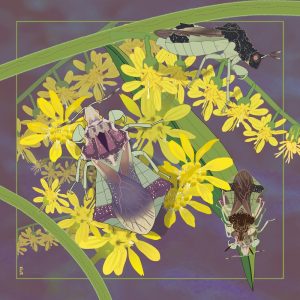 are true bugs: that means they feed by sucking liquids through their hypodermic-needle mouthparts, but they’re not looking for nectar! Instead they are sneaky predators: they can wait for hours or days sitting quietly—and almost invisibly—on a goldenrod bloom, until some unwary insect attracted by the floral bounty of pollen and nectar comes just a bit too close. Their forelegs are very muscular, evolved into grappling hooks that can snatch and hold their unwary prey. Then they impale their victim on their “beak” and suck the unfortunate captive’s nutritious juices.
are true bugs: that means they feed by sucking liquids through their hypodermic-needle mouthparts, but they’re not looking for nectar! Instead they are sneaky predators: they can wait for hours or days sitting quietly—and almost invisibly—on a goldenrod bloom, until some unwary insect attracted by the floral bounty of pollen and nectar comes just a bit too close. Their forelegs are very muscular, evolved into grappling hooks that can snatch and hold their unwary prey. Then they impale their victim on their “beak” and suck the unfortunate captive’s nutritious juices.
They wear effective camouflage, with patches of contrasting yellow, beige, and brown on their cuticle, and flaps on either side of the abdomen that help break up their outline (hence their common name). Their genus name is Phymata, and what I have captured are almost certainly specimens of either P. pennsylvanica or P. americana (their markings are quite variable and they can be hard to identify down to species.)
As I have gone out from day to day to survey the goldenrod blossoms, I have sometimes seen an ambush bug sitting in the same spot day after day, and I am pretty sure I am seeing the same patient predator, waiting in ambush until its next meal gets too close. And as the summer season progresses towards fall, I often find a pair in place, with a male ambush bug perched on the female. Often, these pairs also can be found for several days in the same place, still paired.
In the drawing of ambush bugs on the facing page, you can see a female in the left foreground. Beyond her in the upper right of the drawing sits a male. In the lower right corner there is a mated pair, with the male sitting on top of the female. They are quite different from each other, in coloring and to a lesser extent in size (males are just a bit smaller). In these males you can clearly see the characteristic “granules” that decorate their bodies in both sexes, making them appear almost other-worldly.
Note: one of the photographs in this collection includes an ambush bug that has snagged its next meal; can you find it?
Good Catch!
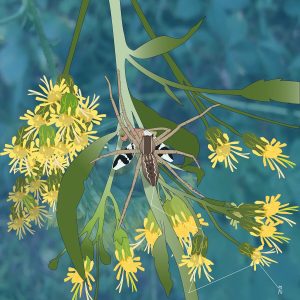 A nursery web spider (Pisaurina mira) and a tephritid fly (Rhagoletis sp., possibly R. completa).
A double-catch: One day in early fall, as I was doing my daily survey of my goldenrods, I spied a spider running rapidly along a goldenrod stalk, and was fortunate enough to catch a photo of it. When I looked closely at the image (sadly out of focus since the spider was whizzing along,) I realized that it was carrying its next meal in its “jaws” (its chelicerae, actually). It took a long time to puzzle out what it had caught. But with the help of several savvy entomologists, and some close scrutiny of what was visible in the photo, I was able to narrow that prey down to a Tephritid fruit fly, possibly one of the species that parasitize walnut hulls. I gave myself a Sherlock Holmes pat on the head for figuring that out.
A nursery web spider (Pisaurina mira) and a tephritid fly (Rhagoletis sp., possibly R. completa).
A double-catch: One day in early fall, as I was doing my daily survey of my goldenrods, I spied a spider running rapidly along a goldenrod stalk, and was fortunate enough to catch a photo of it. When I looked closely at the image (sadly out of focus since the spider was whizzing along,) I realized that it was carrying its next meal in its “jaws” (its chelicerae, actually). It took a long time to puzzle out what it had caught. But with the help of several savvy entomologists, and some close scrutiny of what was visible in the photo, I was able to narrow that prey down to a Tephritid fruit fly, possibly one of the species that parasitize walnut hulls. I gave myself a Sherlock Holmes pat on the head for figuring that out.
Of course I also wanted to know what species of spider I had caught with my iPhone. So I made use of a wonderful online resource, Bugguide, which allows anyone to upload a photo of any insect or spider and ask for an ID; a dedicated group of professional and amateur entomologists constantly survey the ID requests and let you know the result, and this led me by a complicated path† to one of the most interepting stories about this species of spider, which relates to their courtship.
It is a risky business, courting a female spider, and the poor males often end up as a nice dessert after courtship; females have no compunction about devouring their mate in the afterglow of mating (chocolates on the pillow, perhaps?). But nursery web males have devised a countermeasure. As they approach the female, they spin out their silk thread (called a “bridal veil” by students of this spider) to entangle the female’s front legs, making it much harder for her to grab him before he has finished mating. Though the female does quickly slip her bonds, the male’s kinky approach usually gives him time to mate and escape before he can be eaten!
† How I learned more about nursery-web spiders: in my online search for more information, I recognized a familiar name: a brilliant young man who is now a post-doc in my husband’s lab! I’d had no idea that he had studied this species before he arrived in Ithaca, but he was a wonderful resource, and is also one of the folks who helped me identify this spider’s prey; Thank you, Jay Stafstrom!
The Shining Flower Beetle, Olibrus sp.
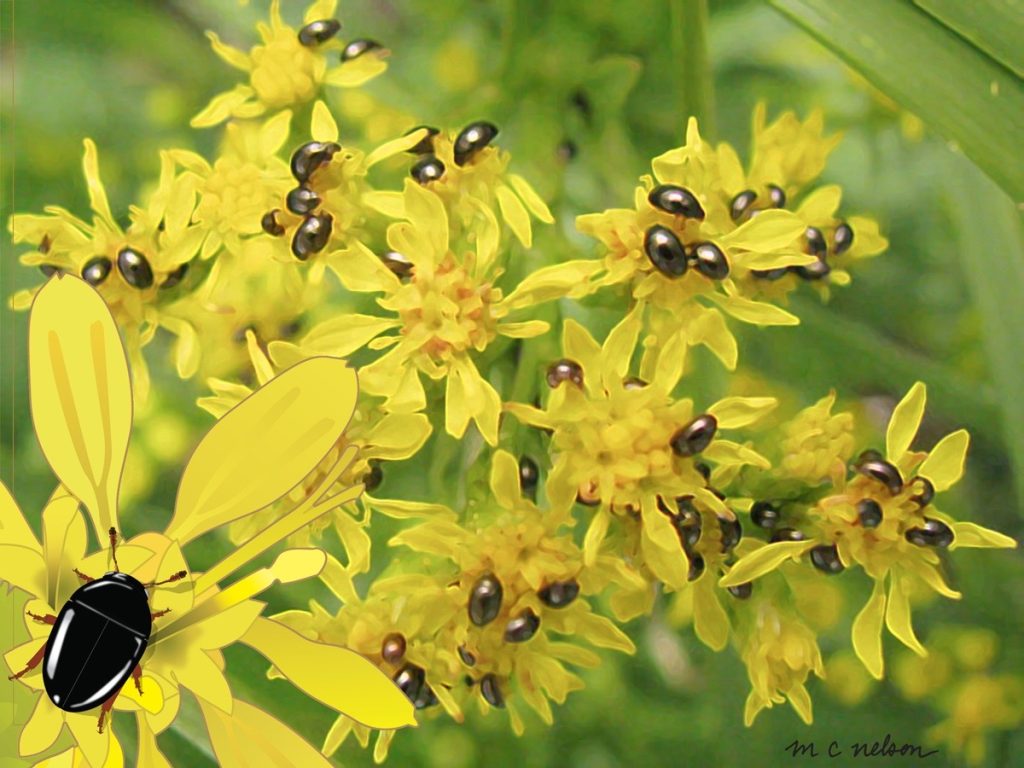 I can’t help thinking of these as the teddy bears of the beetle order (the Coleoptera). They are so rounded and shiny and just plain cute!
I can’t help thinking of these as the teddy bears of the beetle order (the Coleoptera). They are so rounded and shiny and just plain cute!
Despite their name, these little beetles, only ~1.5mm long, feed on pollen, not the flower itself. They lay their eggs among the flower heads too, and their larvae, living nearby deep within the flower heads, do suck sap from stems and leaves. However, they are not, apparently, terribly harmful to the plant in which they reside unless they are very numerous. When the larvae are fully developed and ready to move to their next phase of life, they drop from the flowers to the soil beneath, dig down, and become pupae. In the next summer, when they hatch out as adult beetles, there is their host plant, blooming and ready to accept its hangers-on. (Remember that goldenrod is a perennial).
Each life cycle, from beetle to larva to pupa to beetle, takes one year, and it all happens on and near their favorite flower. They are especially fond of goldenrod, though you will see them on other flowers too.
Wannabees
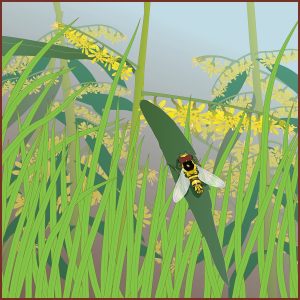 Hoverflies (also called syrphid flies or flower flies) are among those who have evolved strong black and yellow or black and white markings on their bodies, so effective that at first glance it can be hard to believe you are not looking at a bee or a wasp (the two in this collection are Spilomyia longicornis and Allograpta obliqua).
Hoverflies (also called syrphid flies or flower flies) are among those who have evolved strong black and yellow or black and white markings on their bodies, so effective that at first glance it can be hard to believe you are not looking at a bee or a wasp (the two in this collection are Spilomyia longicornis and Allograpta obliqua).
The adults, though, are a bit like parents who send their children out to work so that Mom and Dad can kick back and lead the easy life. As adults most hoverflies literally flit from flower to flower, living on pollen and sweet nectar (and some are important pollinators!). Yet they lay their eggs in dung or rotting meat, or place single eggs in the midst of gatherings of aphids, mealybugs, and other plant pests, where their larvae hatch out and prey very effectively on the pests (so effective are these larval hunters that they are sometimes employed for integrative pest management (IPM)). Their protein-packed childhood diet allows them, as adults, to spurn the hard work and the yucky but nourishing stuff, and live on sugary “junk food”, until it is time to produce the next generation. Romantic, idyllic, perhaps—but keeping their smelly secrets hidden in the nursery!
Playground for Megacyllene
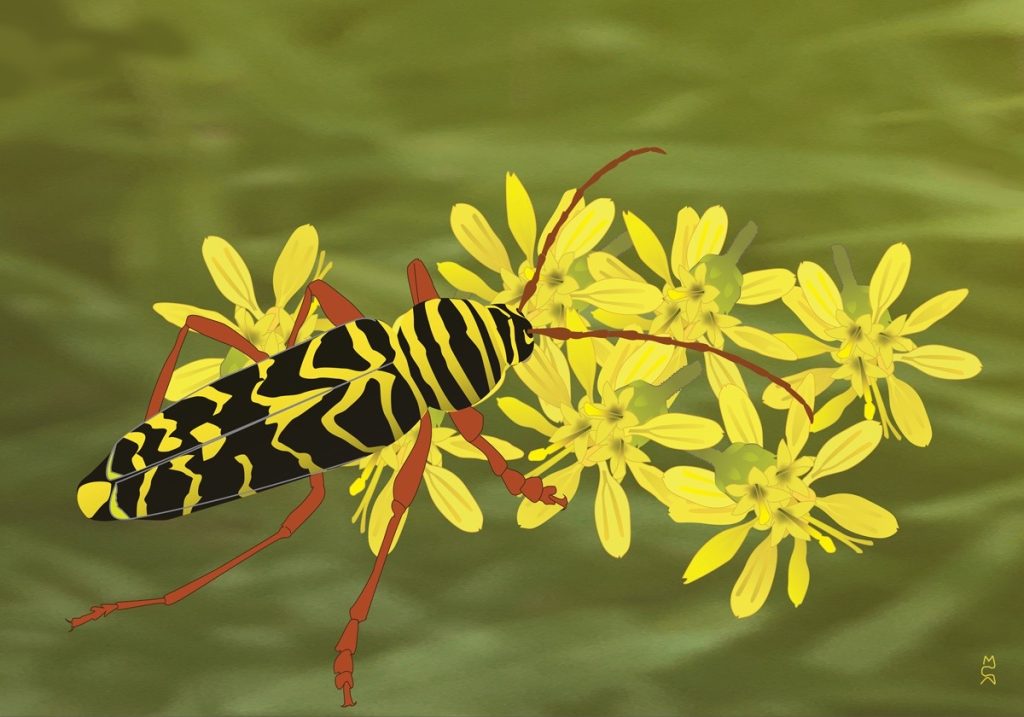 Beautiful, restless longhorn beetles, with a beautiful name†, they glide over the goldenrod blossoms as though the stems were ice and they were luge racers. They are one of our “wanna-bees”; they surely must warn off those predators who hunt insects by vision—they sport gold-and-black stripes like a yellowjacket’s, though more artistically arranged in waves and chevrons. Unfortunately their larvae are very destructive to black locust trees (hence their common name, locust borer), but the adults spend their time feasting on the copious pollen of the goldenrod. Once well fed, they mate (visible in one of the small quartet of stripey insects). The female will head off to find a stand of black locusts and look for a vulnerable crack or crevice in the bark into which it can lay its eggs. The larvae, once hatched, tunnel through the tree’s inner wood, spending the winter safe from storms, and munching onward until they pupate over the summer and emerge as adults late in the season, to begin the cycle again.
Beautiful, restless longhorn beetles, with a beautiful name†, they glide over the goldenrod blossoms as though the stems were ice and they were luge racers. They are one of our “wanna-bees”; they surely must warn off those predators who hunt insects by vision—they sport gold-and-black stripes like a yellowjacket’s, though more artistically arranged in waves and chevrons. Unfortunately their larvae are very destructive to black locust trees (hence their common name, locust borer), but the adults spend their time feasting on the copious pollen of the goldenrod. Once well fed, they mate (visible in one of the small quartet of stripey insects). The female will head off to find a stand of black locusts and look for a vulnerable crack or crevice in the bark into which it can lay its eggs. The larvae, once hatched, tunnel through the tree’s inner wood, spending the winter safe from storms, and munching onward until they pupate over the summer and emerge as adults late in the season, to begin the cycle again.
† I wondered about the origins of this name, and here is what I learned. In ancient Greek, “mega” means large, and “Cyllene” was a famous tree-nymph in Greek mythology. Since Megacyllene infests black locust trees, that seems appropriate in more than one way. Robiniae, its species name, refers to its larva’s favorite host:Robiniae is also the genus name of the locust trees on which it feeds.
Bees and wannabees: Stripes and Stingers
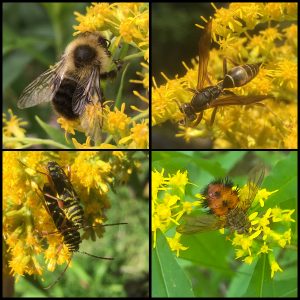 On goldenrod there are always lots of hymenoptera (the order to which bees, ants, and wasps belong), as is evident in this collection, but there are also numerous look-alikes who take advantage of the weaponized wasps’ and bees’ appearance to scare off potential predators (this trick, used throughout the animal world, is called aposematism). Clearly it is a very effective evolutionary trick: there are so many insects that imitate bees or wasps. Several of these hang around goldenrod, blending in with those strikingly striped, stinging wasps and bees. Featured here, clockwise from upper left, are a common eastern bumblebee (Bombus impatiens), a tachinid fly (Hystricia abrupta), the northern paper wasp (Polistes fuscatus), and a pair of longhorned locust borers (Megacyllene robiniae).
On goldenrod there are always lots of hymenoptera (the order to which bees, ants, and wasps belong), as is evident in this collection, but there are also numerous look-alikes who take advantage of the weaponized wasps’ and bees’ appearance to scare off potential predators (this trick, used throughout the animal world, is called aposematism). Clearly it is a very effective evolutionary trick: there are so many insects that imitate bees or wasps. Several of these hang around goldenrod, blending in with those strikingly striped, stinging wasps and bees. Featured here, clockwise from upper left, are a common eastern bumblebee (Bombus impatiens), a tachinid fly (Hystricia abrupta), the northern paper wasp (Polistes fuscatus), and a pair of longhorned locust borers (Megacyllene robiniae).
The bee and the wasp, of course, can own their aura of danger, as they are both stinging insects. The tachinid and the locust borer hope to profit from the dangerous reputations of the other two. Tachinid flies, incidentally, do have their own weaponry, as they lay their eggs on caterpillars and beetles (rather indiscriminately), which then end up being devoured by the fly’s offspring.
A Wasp and Its Copycat
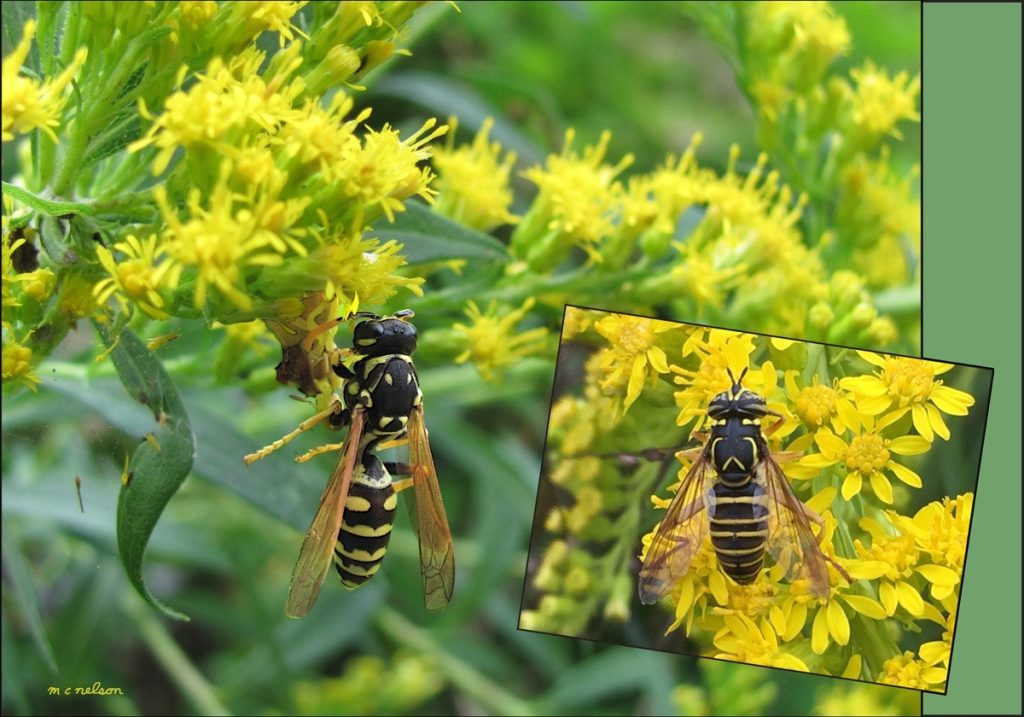 In A Wasp and a Copycat, I combined my photographs of the European paper wasp Polistes dominula, and the syrphid fly Spilomyia longicornis, which to a human eye, and presumably to potential visual predators, is an amazingly effective wasp mimic. Unlike many syrphid flies, Spilomyia lays its eggs in the “rot holes” of fallen trees, where their larvae feed on the rotting material. As adults, like other Syrphids, they feed on pollen and nectar.
In A Wasp and a Copycat, I combined my photographs of the European paper wasp Polistes dominula, and the syrphid fly Spilomyia longicornis, which to a human eye, and presumably to potential visual predators, is an amazingly effective wasp mimic. Unlike many syrphid flies, Spilomyia lays its eggs in the “rot holes” of fallen trees, where their larvae feed on the rotting material. As adults, like other Syrphids, they feed on pollen and nectar.
Spilomyia also makes a high-pitched buzzing sound if disturbed, hypothesized to be an attempt to sound, as well as look, like a wasp. Moreover it typically perches on its four rear legs while waving its forelegs in the air, making it look even more like the wasp it emulates. Vespid wasps like Polistes have long antennae which are in constant motion. Though Spilomyia, like most flies, has short, stubby antennae, it seems that they have evolved a novel way of imitating that waspish antennal behavior, even if that leaves them with fewer legs to stand on.
The European paper wasp is a relatively recent immigrant from Europe, where it flourishes very widely, from Africa through Europe to China. Here in North America, in the ~50 years since its arrival it has already moved out from the East Coast, to the West Coast, the South, and north into both Eastern and Western Canada, as well as parts of South America—and it has also established populations in Australia. Clearly it is a very successful species!
This wasp’s face isn’t visible in my photograph, but both sexes have yellow markings on their faces as well as their bodies. These vary from one individual to another, and the wasps in a nest use the differences in facial markings, learning to recognize their nestmates individually, and to establish dominance relationships among them.
And one more intriguing factoid: the queen-founder of a nest looks after her babies (aka larvae) by feeding them waspish baby food: she carefully chews up caterpillars and other prey into mush to feed her larvae. Once those grow up to be workers, they help in feeding the additional larvae produced by their queen (who can live for a number of seasons, founding a new nest every year; her worker offspring, alas, die off every year at the end of fall.).
Nurseries among the Goldenrod
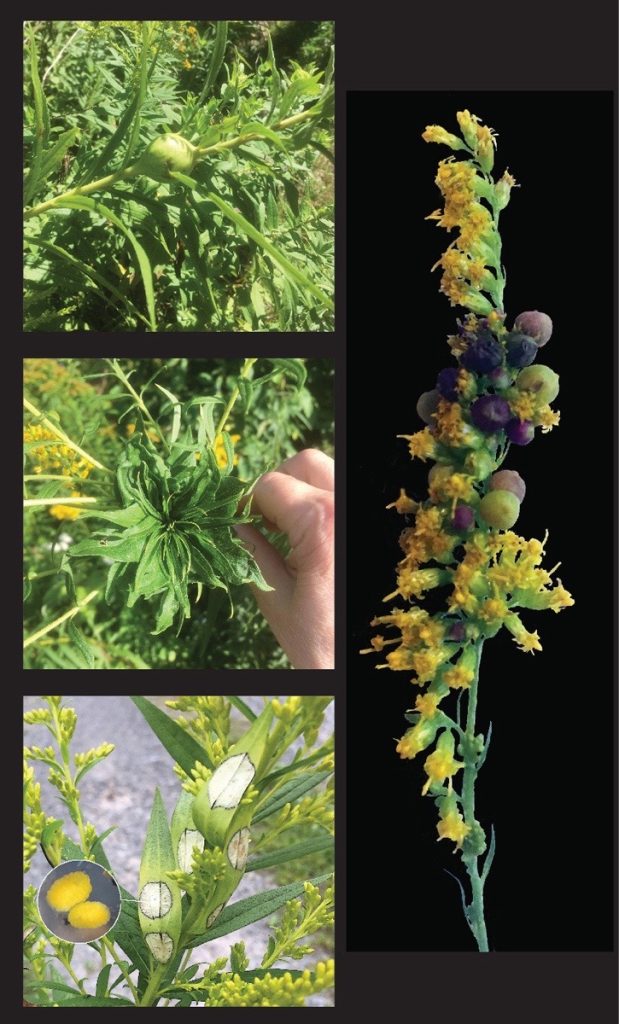 If you happen to walk by a field of goldenrod, you may notice that some of them carry strange marks and swellings on the leaves, stems, or growing tips. These are galls, marks of a way that many insects make good use of goldenrod. These galls are not usually terribly damaging to the plant, and they are of immeasurable value to the insects that created them: they are the nurseries for a number of different species—flies, midges, wasps and moths, among others. All the galls here, though, were formed by various kinds of flies. The four types I have found on my walks are:
If you happen to walk by a field of goldenrod, you may notice that some of them carry strange marks and swellings on the leaves, stems, or growing tips. These are galls, marks of a way that many insects make good use of goldenrod. These galls are not usually terribly damaging to the plant, and they are of immeasurable value to the insects that created them: they are the nurseries for a number of different species—flies, midges, wasps and moths, among others. All the galls here, though, were formed by various kinds of flies. The four types I have found on my walks are:
Leaf gall (lower left): these silvery patches are an amazing example of the complex relationships that sustain the “circle of life”. They are formed by a species of midge (very small members of the fly family) called Asteromyia carbonifera. At one time it was thought that these rather attractive patches on goldenrod leaves were caused by a fungus, Botryosphaeria dothidea, and there is a grain (or a spore) of truth to that assumption. In fact this midge and a specific species of fungus share a symbiotic relationship. In simple terms, the midge needs the fungus, and the fungus needs the midge, in order to flourish! The female Asteromyia flies carry spores in a specialized structure, close to their ovipositor, called a mycangium, and when they lay an egg into the leaf, some fungal spores go along. Now, in the case of Eurosta and most other gall-forming insects, it is secretion or irritation by the larval offspring of the insect that causes a gall to form, but in this case, it is apparently the fungus that stimulates the leaf to form a gall. The midge’s larvae feed on the fungus that is growing, along with them, inside the leaf (instead of using the leaf tissue itself). Moreover, the fungus creates a tough outer layer for the gall and helps to protect the midge maggots and pupae from the depredations of the parasitoid wasp Torymus capitae. The wasp probes the gall with its ovipositor seeking to lay an egg in the immature flies; however, their ovipositors cannot easily penetrate the fungal stroma. [I really have to pause at this point to say, “Ain’t Mother Nature wonderful!!!” There are so many incredible evolutionary stories to be found here, especially within the wonderful world of goldenrod!] I found most of the story of Asteromyia and its fungus here. (My thanks to Dr. Joe Boggs, OSU, for allowing me to make use of his essay.)
Tip aka bunch galls (middle left): Another midge (Rhopalomyia solidaginis) causes these leafy bunch galls, and I am sure there is a fascinating story to tell about these as well; there is just not enough space to tell all the stories of goldenrod and its dependents!
Stem or ball galls (top left): see the commentary below on the Eurosta fly.
Flower galls (on the right): The work of the goldenrod flower gall midge (Schizomyia racemicola). Yet another midge, it lays its eggs on the buds of goldenrod flower sprays, causing galls that look very much like tiny fruits.
Eurosta solidaginis
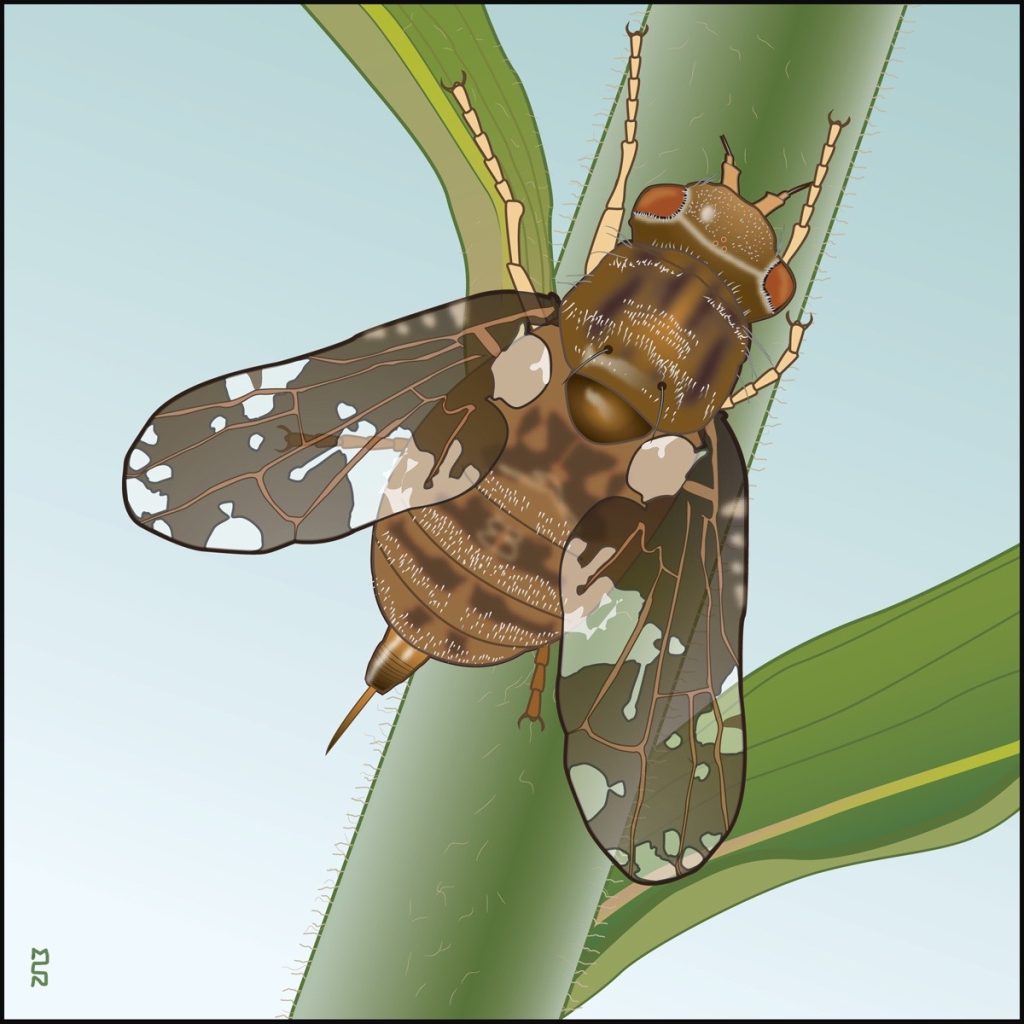 (aka the goldenrod gall fly) is utterly dependent on goldenrod for its survival. Here is its story:
These little flies, only around 5mm long, emerge in the spring, mate, and lay their eggs in the first growth bud of a goldenrod plant, usually one egg per plant. When a larva hatches from the egg, it burrows down inside the plant’s stem and there induces a gall to form around its body, secreting irritants that cause overgrowth in the plant. The inside of the gall is rich in protein and starch and provides both food and protection for the larva (though see below!). The Eurosta larva lives, feeds, and grows in its gall all summer, and during that time a hard shell develops around the gall. As fall approaches, the larva chews an escape tunnel, but it does not chew all the way to the outside; instead, it leaves a thin wall between the inside and the outside world, a kind of trapdoor-in-waiting, that will be easy to break through come spring. Then it settles down through the winter in a state of diapause (a “resting state” in which the larva lowers its metabolism). You might wonder how it survives as winter cold comes along, but it has a clever strategy for that: cooling weather triggers the production of several “antifreeze” compounds in its tissues, that help keep it from freezing (one of those is a glycol, very much like what you put in your car’s radiator!). If it is lucky, it will survive to pupate and hatch into an adult fly the next spring. Males usually hatch before females do, ready to mate as soon as the females emerge, and they need to do so quickly. These adult flies hatch without any mouthparts, and therefore live, at most, a couple of weeks, dependent on whatever food reserves they acquired as larvae. So they need to get down to business right away, finding a mate so their life cycle may begin again.
(aka the goldenrod gall fly) is utterly dependent on goldenrod for its survival. Here is its story:
These little flies, only around 5mm long, emerge in the spring, mate, and lay their eggs in the first growth bud of a goldenrod plant, usually one egg per plant. When a larva hatches from the egg, it burrows down inside the plant’s stem and there induces a gall to form around its body, secreting irritants that cause overgrowth in the plant. The inside of the gall is rich in protein and starch and provides both food and protection for the larva (though see below!). The Eurosta larva lives, feeds, and grows in its gall all summer, and during that time a hard shell develops around the gall. As fall approaches, the larva chews an escape tunnel, but it does not chew all the way to the outside; instead, it leaves a thin wall between the inside and the outside world, a kind of trapdoor-in-waiting, that will be easy to break through come spring. Then it settles down through the winter in a state of diapause (a “resting state” in which the larva lowers its metabolism). You might wonder how it survives as winter cold comes along, but it has a clever strategy for that: cooling weather triggers the production of several “antifreeze” compounds in its tissues, that help keep it from freezing (one of those is a glycol, very much like what you put in your car’s radiator!). If it is lucky, it will survive to pupate and hatch into an adult fly the next spring. Males usually hatch before females do, ready to mate as soon as the females emerge, and they need to do so quickly. These adult flies hatch without any mouthparts, and therefore live, at most, a couple of weeks, dependent on whatever food reserves they acquired as larvae. So they need to get down to business right away, finding a mate so their life cycle may begin again.
Eurosta needs some luck to complete its life cycle, though. Those grubs inside the gall are tempting to a number of predators. There are wasps which seek out the galls and lay their eggs in them, so their larvae can feed on the Eurosta larva; there are tiny beetles that do the same. The galls are also targets for some overwintering birds, chickadees, downy woodpeckers, and others, that attack the galls and extract the defenseless larva. But, if the larvae make it through summer, fall, and winter, they will begin the whole process again in the spring, pushing their way through their “trapdoor” as adults, just as their favored goldenrod plants (which are perennials) begin to sprout. Then newly emerged Eurosta males start to dance atop the goldenrod sprouts, hoping to attract a female for mating. The females of E. solidaginis are very fussy, by the way, and will only lay eggs on a few species of goldenrod, mainly just three (S. canadensis, S. gigantea, and S. altissima). You might wonder how they can tell which species are acceptable. To some extent they taste the plants with their feet and antennae, but the females also have what are hypothesized to be taste receptors on that wicked-looking tip of its ovipositor (shown in my drawing, though that sharp end is usually kept hidden inside ). So they may pierce a sprout, taste it with the tip, and then decide whether it deserves to be gifted with a Eurosta egg.
Even Mosquitoes like dessert!
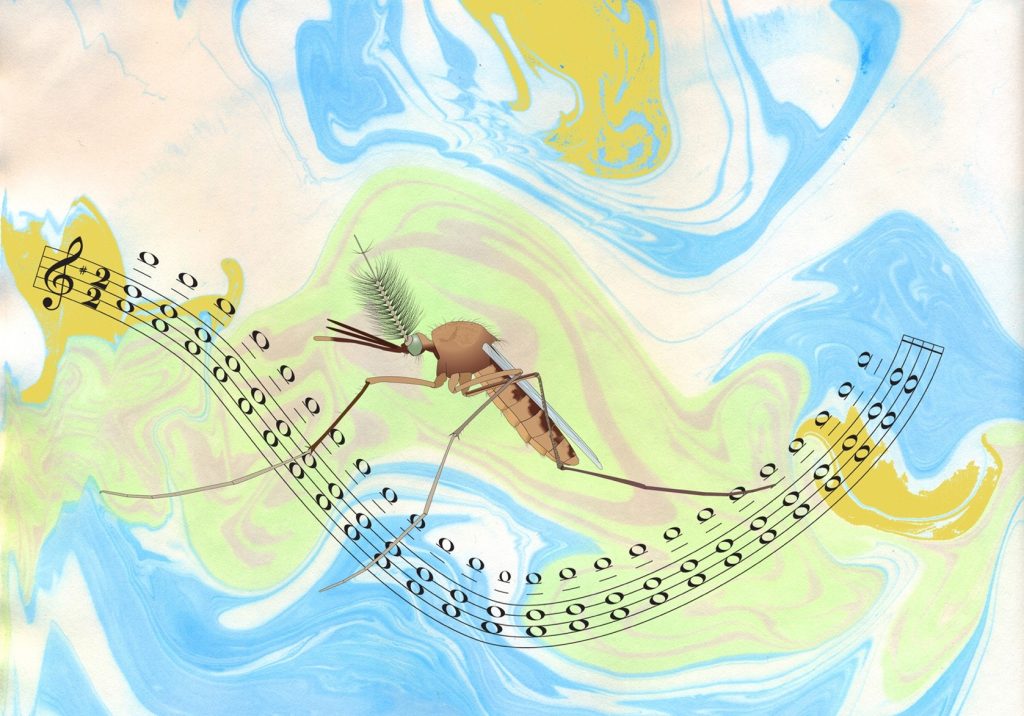 You might be surprised to find a mosquito in this collection, but even mosquitoes like dessert! If you squint at the small plaque, you can see the tiny mosquito perched on a spray of goldenrod: the mosquito in that photograph is actually a female (most likely Culex pipiens, our most common species locally), but I chose to draw a male, because of its magnificently bushy antennae. These are essential to the perpetuation of the mosquito tribe, because they are how he finds a mate. His antennae are actually delicate and sensitive hearing organs that allow him to find females. He can hear the whine of their wingbeats (as we do—so annoying on a summer night for us!). But while we are trying to squash the whiner, he homes in on females by that sound, using his antennal “ears” to track them down. And if he gets lucky, there will soon be a new generation of these annoying insects.
You might be surprised to find a mosquito in this collection, but even mosquitoes like dessert! If you squint at the small plaque, you can see the tiny mosquito perched on a spray of goldenrod: the mosquito in that photograph is actually a female (most likely Culex pipiens, our most common species locally), but I chose to draw a male, because of its magnificently bushy antennae. These are essential to the perpetuation of the mosquito tribe, because they are how he finds a mate. His antennae are actually delicate and sensitive hearing organs that allow him to find females. He can hear the whine of their wingbeats (as we do—so annoying on a summer night for us!). But while we are trying to squash the whiner, he homes in on females by that sound, using his antennal “ears” to track them down. And if he gets lucky, there will soon be a new generation of these annoying insects.
Though we know mosquitoes by their bite, it is only the females that plague us—they need a blood meal to ripen their eggs. The males are not blood suckers at all; instead they feed on nectar, and if one looks closely one can often see them, mixing with the other nectar lovers on the flowers that offer that delight.
In this slightly fantastic view, I have rendered an accurately-drawn male, with his huge, sensitive antennal hairs. At the base of his antenna you can see a doughnut-shaped structure, nestled into his greenish eye: this is his Johnston’s organ, packed chock-full of sensory neurons, activated by those delicate hairs as sound waves waft past, thus alerting the mosquito to the sounds of his beloved’s wingbeats (the ones we hate to hear!).
There is a fascinating story about those sounds, too, for the Aedes aegypti mosquito. See the musical accompaniment winding through the air behind this mosquito? It expresses the songs of both males and females: in flight, females’ wings make a hum at about 400 cycles per second, roughly equivalent to A on a piano; males’ wingbeats hum at higher pitch, at about 600 cycles per sec., around a D above high C. But when male and female are in courting mode, the male adjusts his wing beat so he is in phase with the female, and this creates an overtone (harmonic) at a higher pitch (the highest note on this musical staff). Only when that overtone is in the air will the couple mate—a harmonic convergence, so to speak!
My thanks to Professor Ronald Hoy for the details of the Aedes story!
The End of the Season
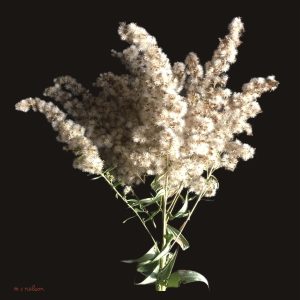 Goldenrod is still beautiful as autumn moves in for real, when its flower heads turn to balls of fluff. These are seeds that will sustain many overwintering birds, as well as squirrels and other small mammals. As for the varied galls that are to be found among goldenrod’s drying stalks, birds may finish off the inhabitants of some of those galls before their time, and find their contents a good means of sustaining themselves through the winter months, but the luckier inhabitants of the galls are snugly tucked away and set to overwinter. If they make it through the winter, they will chew or worm their way out of their protective “nurseries” in the spring, and head out to start another generation of flower-loving creatures who depend on that wealth of gold.
Goldenrod is still beautiful as autumn moves in for real, when its flower heads turn to balls of fluff. These are seeds that will sustain many overwintering birds, as well as squirrels and other small mammals. As for the varied galls that are to be found among goldenrod’s drying stalks, birds may finish off the inhabitants of some of those galls before their time, and find their contents a good means of sustaining themselves through the winter months, but the luckier inhabitants of the galls are snugly tucked away and set to overwinter. If they make it through the winter, they will chew or worm their way out of their protective “nurseries” in the spring, and head out to start another generation of flower-loving creatures who depend on that wealth of gold.
Other denizens of goldenrod left offspring that dug into the earth below their favorite flowers and overwintered underground. Those will burrow their way up into the warming air to emerge as adults. All these creatures will come out ready to feed, meet, mate, and start a new cycle of life, as the goldenrod that nourished them begins to sprout and start a new generation of floral abundance.
Goldenrod is truly an amazing plant—the uhr-mother of its own ecosystem of birds and mammals, and of course, especially, all manner of insects and even fungi, through a complex web of interrelated and interdependent organisms. Common as they are, I now see each rising plant as an individual; each has enriched my daily walks in the fields. I feel very fortunate to have had the chance to explore just the tiniest corner of this amazing world.
